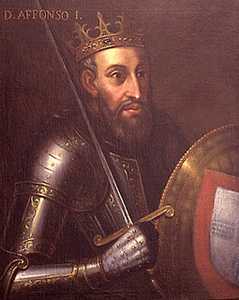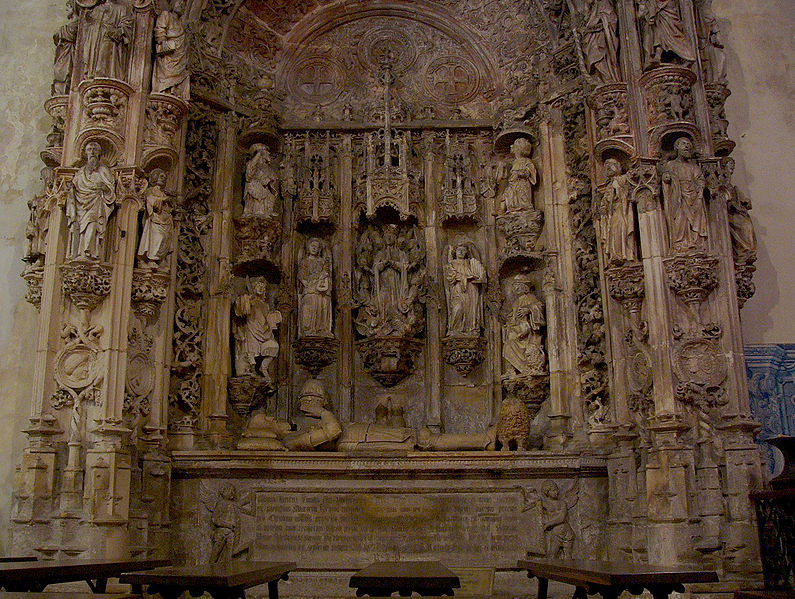<Back to Index>
- Biophysicist Rosalind Elsie Franklin, 1920
- Composer Agostino Steffani, 1654
- King of the Portuguese Afonso I Henriques, 1109
PAGE SPONSOR


Afonso I or Dom Afonso Henriques (c. 1109, Guimarães or Viseu – 6 December 1185, Coimbra), more commonly known as Afonso Henriques, nicknamed "the Conqueror" (Portuguese: o Conquistador), "the Founder" (o Fundador) or "the Great" (o Grande) by the Portuguese, and El-Bortukali ("the Portuguese") and Ibn-Arrik ("son of Henry", "Henriques") by the Moors whom he fought, was the first King of Portugal. He achieved the independence of the southern part of the Kingdom of Galicia — County of Portugal — from the Kingdom of León, in 1139, doubling its area with the Reconquista, an objective that he pursued until his death, in 1185, after forty-six years of wars against the Moors.
Afonso I was the son of Count Henry of Burgundy, regent of Portugal, and Queen Teresa, Countess of Portugal, the natural daughter of King Alfonso VI of León, heir by his grandmother of the first County of Portugal, which she received as a personal dowry. Afonso took the title of King of the Portuguese on 25 July 1139, immediately after the Battle of Ourique, acclaimed by his army, and died on 6 December 1185 in Coimbra.
At the end of the 11th century, the Iberian Peninsula political agenda was mostly concerned with the Reconquista, the driving out of the Muslim successor states to the Caliphate of Córdoba after its collapse. With European military aristocracies focused on the Crusades, Alfonso VI called for the help of the French nobility to deal with the Moors.
In exchange, he was to give the hands of two of his daughters in
wedlock to the leaders of the expedition and bestow royal privileges to
the others. Thus, the royal heiress Urraca of León wedded Raymond of Burgundy, younger son of William I, Count of Burgundy, and her half - sister, princess Teresa, wedded another French crusader, Henry of Burgundy, younger brother of Hugh I, Duke of Burgundy. Henry was made regent of Portugal during the minority of his childish wife, a burdensome county south of Galicia,
where Moorish incursions and attacks were to be expected. Afterward
succeeded by his wife Teresa in the same independent politic as rulers
of Portugal, Henry had withstood the ordeal and initiated in Rome a
politic of freeing their personal fief from suzerainty to
the Leonese monarchy. In fact, the Visigoth Law established at the time
that fiefs were personal property, and that crowns and kingdoms were to
be shared in equal parts by all the children, which explains Teresa's
claims to the Galician County of Portugal her father inherited from her
grandmother among several other kingdoms and crowns, after he defeated
his two kingdom sharing dead brothers, the King of Galicia and
Portugal, and the King of Castile. From this marriage several children were born, but only one son, Afonso Henriques (meaning
"Afonso son of Henry") survived. Infante Afonso, born in 1109, took the
title of Prince after taking the throne of his mother, supported by the
generality of the Portuguese nobility who disliked the alliance between
Galicia and Portugal Queen Teresa had come to, marrying a second time
the most powerful Galician count. In 1120, the young prince took the
side of the archbishop of Braga,
a political foe of Teresa, and both were exiled by her orders. In 1122
Afonso became fourteen, the adult age in the 12th century. He made
himself a knight on his own account in the Cathedral of Zamora, raised an army, and proceeded to take control of his lands. Near Guimarães, at the Battle of São Mamede (1128) he overcame the troops under his mother's second husband and ally Count Fernando Peres de Trava of Galicia, exiling her forever to a monastery in
Galicia. Thus the possibility of re-incorporating Portugal (up to then
Southern Galicia) into a Kingdom of Portugal and Galicia as before was
eliminated and Afonso became sole ruler (Duke of Portugal) after demands for independence from the county's church and nobles. He also vanquished Alfonso VII of León,
came to the rescue of his mother, whose nephew he was, and thus freed
the kingdom from political dependence on the crown of his cousin of
León. On 6 April 1129, Afonso Henriques dictated the writ in
which he proclaimed himself Prince of Portugal. Afonso
then turned his arms against the persistent problem of the Moors in the
south. His campaigns were successful and, on 25 July 1139, he obtained
an overwhelming victory in the Battle of Ourique, and straight after was unanimously proclaimed King of the Portuguese by
his soldiers, establishing his equality in rank to the other realms of
the Peninsula. The so called first assembly of the estates - general
convened at Lamego (wherein
he would have been given the crown from the Archbishop of Braga, to
confirm his independence) is a 17th century embellishment of Portuguese
history. Independence
from Alfonso VII of León's suzerainty, however, was not a thing
he just could achieve military. The County of Portugal still had to be
acknowledged diplomatically by the neighboring lands as a Kingdom and,
most importantly, by the Roman Catholic Church and the Pope. Afonso wed Maud of Savoy, daughter of Amadeus III, Count of Savoy,
and sent ambassadors to Rome to negotiate with the Pope. He succeeded
to relinquish suzerainty to his cousin Alfonso VII of León,
becoming instead a subject of the papacy, as the kingdoms of Sicily and
Aragón had done before him. In 1179 the bull Manifestis Probatum accepted the new King as vassal to the Pope exclusively. In
Portugal he built several monasteries and convents and bestowed
important privileges to religious orders. He is notably the builder of Alcobaça Monastery, to which he called the Cistercian Order of his uncle Bernard of Clairvaux of Burgundy. In 1143, he wrote to Pope Innocent II to
declare himself and the kingdom servants of the Church, swearing to
pursue driving the Moors out of the Iberian Peninsula. Bypassing any
king of León, Afonso declared himself the direct liegeman of the Papacy. Thus, Afonso continued to distinguish himself by his exploits against the Moors, from whom he wrested Santarém and Lisbon in 1147. He also conquered an important part of the land south of the Tagus River, although this was lost again to the Moors in the following years. Meanwhile,
King Alfonso VII of León (Afonso's cousin) regarded the
independent ruler of Portugal as nothing but a rebel. Conflict between
the two was constant and bitter in the following years. Afonso became
involved in a war, taking the side of the Aragonese king, an enemy of
Castile. To ensure the alliance, his son Sancho was engaged to Dulce, sister of the Count of Barcelona, and princess of Aragon. Finally, in 1143, the Treaty of Zamora established peace between the cousins and the recognition by the Kingdom of León that Portugal was a sovereign kingdom. In 1169 the now old Dom Afonso was disabled in an engagement near Badajoz by
a fall from his horse, and made prisoner by the soldiers of the king of
León, his son - in - law. Portugal was obliged to surrender as his
ransom almost all the conquests Afonso had made in Galicia (north of
the Minho) in the previous years. In 1179 the privileges and favours given to the Roman Catholic Church were compensated. In the papal bull Manifestis Probatum, Pope Alexander III acknowledged
Afonso as King and Portugal as an independent crown with the right to
conquer lands from the Moors. With this papal blessing, Portugal was at
last secured as a kingdom. In 1184, in spite of his great age, he still had sufficient energy to relieve his son Dom Sancho, who was besieged in Santarém by the Moors. Afonso died shortly after, on 6 December 1185. The
Portuguese revere him as a hero, both on account of his personal
character and as the mythical founder of their nation. There are
stories that it would take 10 men to carry his sword, and that Afonso
would want to engage other monarchs in personal combat, but no one
would dare accept his challenge.
In July 2006, the tomb of the king (which is located in the Santa Cruz Monastery in Coimbra) was to be opened for scientific purposes by researchers from the University of Coimbra (Portugal), and the University of Granada (Spain). The opening of the tomb provoked considerable concern among some sectors of Portuguese society and IPPAR – Instituto Português do Património Arquitectónico (Portuguese State Agency for Architectural Patrimony). The government halted the
opening, requesting more protocols from the scientific team because of
the importance of the king in the nation's formation.